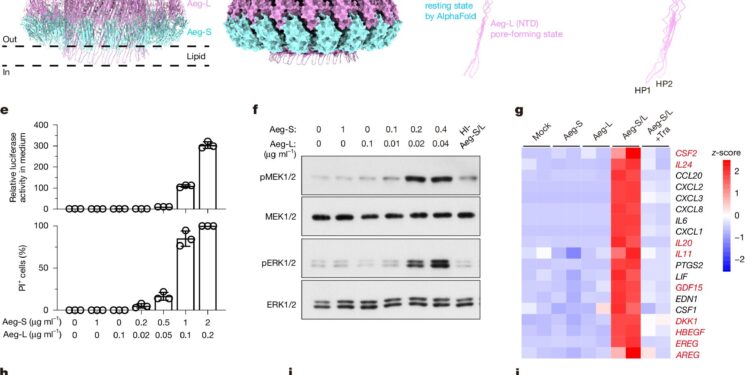Structural and functional characterization of the AEG-S and AEG-L Pore complex. Credit: Nature (2025). DOI: 10.1038 / S41586-025-09331-1
Scientists from the National Institute of Biological Sciences, Beijing, report that two proteins forming pores of the epithelial membranes of the respiratory tract of the common mold of alternative mold which lead to inflammation of the allergic respiratory tract.
Allergens that cause type 2 immunity such as mites, pollen and mold spores share little structural similarity. Diagram recognition receptors manage bacterial and viral threats, while type 2 responses seem to detect the disruption of the tissues instead.
MAPK signaling works as a molecular standard inside epithelial cells, transforming external stress into controls at the gene. The IL-33 is an alarm signal cytokine which normally remains nestled inside the nuclei of the cells of the respiratory tract but go out when the membranes break, rally the innate immune cells and leads a response. In allergic respiratory tract, MAPK activity amplifies the programs launched by IL-33, so that the two molecules are at the center of inflammation.
In the study, “the perforation of the membrane of epithelial cells induces allergic inflammation of the respiratory tract”, published in NatureThe researchers have designed a purification and reconstruction strategy to test whether fungal proteins can initiate type 2 inflammation by epithelial detection.
Human pulmonary epithelial cell lines and repeated exposure of intranasal proteins in mice served as experimental systems, with early activation followed by the release of IL-33, Mapk phosphorylation and the expression of the inflammatory gene.
Scientists discovered two Alternaria Alternata, AEG-S and AEG-L monthly proteins, which combine to unravel the membranes of the respiratory tract cells. The images show them connected as a drill in the shape of a ring. A low exposure allows you to rush inside the calcium and turns on a MAPK relay. A heavier exposure bursts the cells and releases the IL-33 alarm signal. Each protein is produced without any effect.
The blocking of the calcium input or the MAPK relay was sufficient to stop each response downstream. Breathing in the duo leads to classic signs of allergy in mice, with eosinophiles in the lungs, T-Helper-2 cells and an rising IgE, while mold designed to miss one or the other protein leaves calm respiratory tract.
Six toxins of pores structurally not linked from fungi, bacteria, annelides and cnidaires caused similar epithelial and immune characteristics during exposure to the respiratory tract, including the release of IL-33 and the MAPK activation in epithelial cells even without retroacction IL-33.
The study data indicate that the perforation of the membrane records as a danger and is sufficient to launch type 2 immune paths in the epithelium of the respiratory tract. The authors argue that many allergens and otherwise uninformed venoms bear proteins forming pores, so that the perforation can explain why various stimuli cause similar inflammation of the respiratory tract.
Written for you by our author Justin Jackson, edited by Sadie Harley, and verified and revised by Robert Egan – This article is the result of meticulous human work. We are counting on readers like you to keep independent scientific journalism alive. If this report matters to you, please consider a donation (especially monthly). You will get a without advertising count as a thank you.
More information:
Kejian Shi et al, perforation of the membrane of epithelial cells induces allergic inflammation of the airways, Nature (2025). DOI: 10.1038 / S41586-025-09331-1
© 2025 Science X Network
Quote: Duo of membrane drilling mold protein involved in the allergies of the respiratory tract (2025, August 4) recovered on August 5, 2025 from
This document is subject to copyright. In addition to any fair program for private or research purposes, no part can be reproduced without written authorization. The content is provided only for information purposes.



